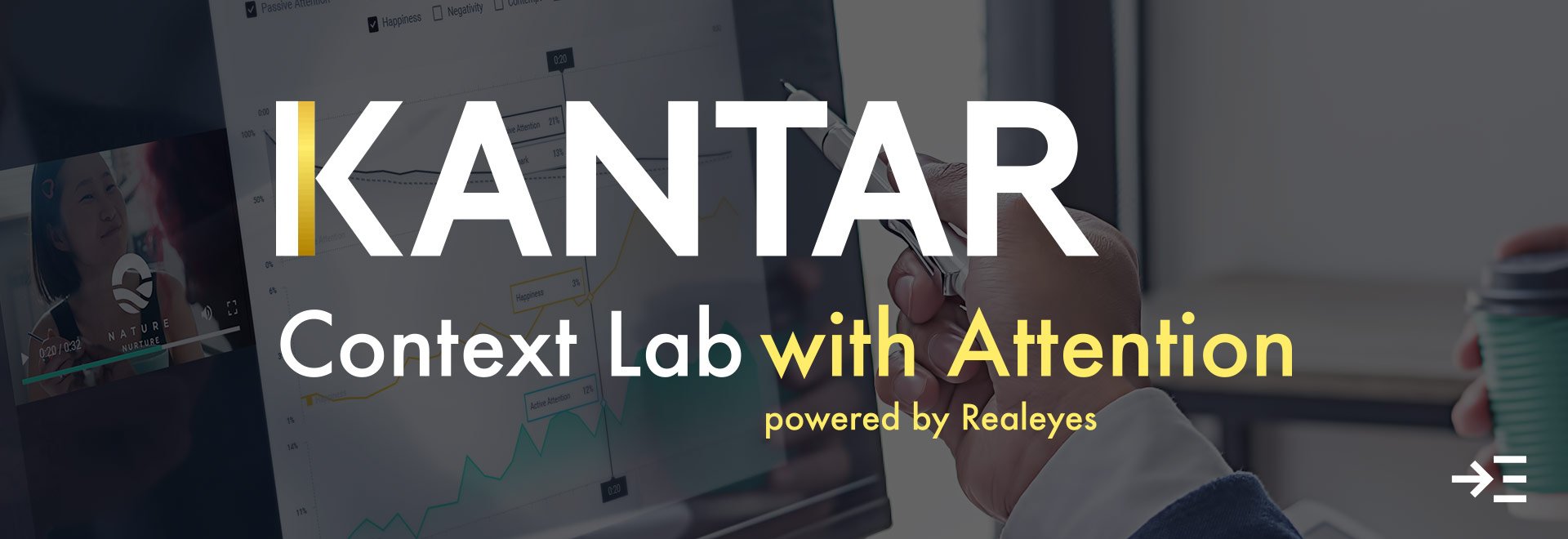
Kantar's Comprehensive Approach to Attention

Keith O'Brien
Duncan Southgate, Senior Director of global creative in Kantar’s Insights division, is a creative, media, and brand insights expert passionate about delivering practical and efficient solutions to make advertising and media plans better.
He spoke to Realeyes about why the more visual attention you get, the better your chances of driving sales and building your brand; shared details why Kantar’s new partnership with Realeyes adds a missing puzzle piece; and discussed the importance of context in determining which ads are working well.
Why is attention important when it comes to advertising? And why are we talking about it so much in 2023?
Yeah, what a great question. We should say it's always been important upfront. It has not suddenly become important. But the measurement of it has maybe become more important.
We've long known that you needed attention before you could start to achieve any outcomes for advertising. That's always been true. But our ability to measure that has never been as good as it is today. Philosophically, we at Kantar buy into the idea that attention is a very important stepping stone on the path to effectiveness.
|
We've got very clear evidence that the more visual attention you get, the better your chances of building a brand and driving sales. |
You can't have any significant impact without some visual attention for video advertising in particular. We've got very clear evidence that the more visual attention you get, the better your chances of building a brand and driving sales.
Talk a little bit about Kantar history with attention, and how you've approached it over time.
It is quite a long track record if you take it back to when Millward Brown (now Kantar) was running brand tracking studies. We always knew that attention was really important. We were always measuring things like ad recall, which was the outcome of attention in brand trackers.
We knew that some attention had happened before we got to that outcome, but, actually, explicitly measuring human attention we've been doing that now, for just over a decade using facial coding. And we’re still big fans of the facial coding approach for measuring human visual attention. We believe that's the best way to get to that observed data at scale around the world.
Over the last decade or so, we've gathered attention data for well over 50,000 ads across TV and digital contexts. For most of that data, we have the combination of observed human attention with attitudinal insights and outcomes as well. So that's pretty cool.
|
And we’re still big fans of the facial coding approach for measuring human visual attention. We believe that's the best way to get to that observed data at scale around the world. |
We've also got a stack-load of machine-based playback data, such as how long the ad was being shown as well as how many seconds people were looking at it. And we've got that for all kinds of different digital contexts.
We've got a large data set that we've learned quite a lot from, but definitely, what’s hotted up massively in the last two to three years is that the attention debate has become much more nuanced. In the last couple of years, we’ve spent a lot of time validating and exploring the relationships between attention data and outcomes and trying to better understand the underlying science of attention.
We've also been looking for ways to optimize our attention measurement approaches, and we're now in a position where we're able to measure it better than ever before.
So what are some of the trends that you or Kantar are mindful of, such as creative and media attention? Should they be viewed in coordination or be viewed separately?
There's going to be a lot more granular understanding about what drives attention. Moving forward as data sets get more sophisticated, particularly in the digital space, there will be more understanding of how attention works in all kinds of different contexts. Our focus at Kantar is less on pure play media attention and more on creative attention in isolation, and also on the creative and media intersection.
What I'm interested in is how the growing usage of attention and media planning is going to link back to questions about how much creative can or can't play a role in increasing that amount of attention.
|
What I'm interested in is how the growing usage of attention and media planning is going to link back to questions about how much creative can or can't play a role in increasing that amount of attention. |
The elasticity of a particular media format certainly needs to be understood, and that typical range of attention may for example be three to five seconds for one format. But I'm most interested in the question of how you can make sure that you're the advertiser getting the five seconds of attention rather than the three or 15 seconds rather than ten. That's where we'll be focusing our efforts. And I expect the sophistication of client questions to ramp up.
We've done a lot to justify that attention matters. But now the questions will be more about how much attention we need for our brand in this context for this objective, and then, which creative approaches help us to capture and retain enough attention to get above that threshold. It will become more granular, more campaign, and client or brand specific. We're really only at the start of the journey of understanding everything we need to about attention.
Can you talk a bit about Kantar’s new partnership with Realeyes? Tell us why it's important and what people in the industry should know about it?
The kinds of attention metrics that Kantar cares most about are observed human attention measures. At an execution level we don't believe it’s something you can really just ask about. We've seen some competitors just asking - how much attention would you pay to this ad; we don't believe that's a legitimate way to do it.
|
what we like about the Realeyes technology is that it allows us to get really good human measurement into our product around the world. |
We believe you need to observe attention to get an accurate measure. You can predict it to some extent and that's definitely also something that we think is important and useful for measurement of attention at scale. But what we like about the Realeyes technology is that it allows us to get really good human measurement into our product around the world. And the product we've chosen to put it into is our Context Lab.
Context Lab is a combination product – it sits at the intersection of creative and media. It has media metrics because it puts ads into a specific context such as YouTube, TikTok, Facebook, Instagram, etc. And we then look at the delta in brand lift between control and exposed groups. We've therefore got a brand outcome, even though it's a lab test, tied to specific media.
We've also got lots of creative diagnostics in these studies. As well as seeing whether the ad is working in that context, we ask questions like, 'Was it enjoyable, or well branded?'
Behaviour is the third element of these studies. Until now we've just been measuring the playback. But we've only known what was playing on the machine. We didn't know whether people were looking, engaging, paying attention or whether they were just drifting off, letting the ad run while waiting for the survey to start.
That's where Realeyes has stepped in. We're now adding Realeyes attention measurement into Context Lab. It's the missing piece in the puzzle that allows us to go from playback through to attention through to having some kind of effect, and then seeing whether it drove a brand lift outcome or not.
We've now got the best of both worlds, creative and media attention and attitudes, observed and expressed all in one place. It's a really cool package. We've got existing norms and databases. We can do these studies all around the world at scale, and I'm very excited about ramping up the partnership.
What is your or Kantar’s view of the role of AI and predictions when it comes to measuring attention?
It already plays a role, and this will only increase. Our overall view on measurement for creative is that we expect the future to be hybrid. We are investing in both. So we continue to invest in survey-based methods, but also AI predictive techniques.
When it comes to attention in particular, we already have the ability within our AI pre-tests to predict playback. We can already predict what we would consider to be an active attention measure, and we may well expand in this area in the future. But I think overall what we need to do first is get as much attention measurement in as many contexts as we can using observed data. That's the richest, most helpful diagnostic at this stage.
|
...my primary focus at the moment is extending our observed attention data set. Particularly so we can understand digital contexts better. |
Additionally, we're already using predictive AI eye tracking to help with attention and measure what people are most likely looking at within elements of an ad in combination with these other measures. I expect we'll be using AI more and more to help us measure and understand attention. But my primary focus at the moment is extending our observed attention data set. Particularly so we can understand digital contexts better.
What's your advice for any organization that is relatively new to embracing attention, whether it's an advertiser or agency, to get up to speed?
I don't think it needs to be too complicated. We’re trying to make it easy to get attention data. It's now baked into our existing products. So you don't have to set up a whole different attention measurement agenda and products that need attention. For creative measurement we believe attention should essentially be coming along as standard. So that's where I would start.
We think it's important to integrate attention measurement with other outcomes because while more attention is generally a good thing if you have ten seconds of attention, but you forget to mention the brand during that time, the ad will still be rubbish.
You can't forget all the other good things that you know about creative effectiveness such as branding, what message people take out, and persuasiveness. Attention is a very helpful complement to those other metrics. But you need an integrated package to fully understand whether and how an ad is going to work.
